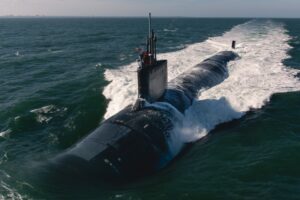Future Frigate (FFG(X))
-
 Navy/USMC
Navy/USMCNavy Cites Reasons For Ditching DART Sonar For LCS, Frigate
A Navy official this week cited technical challenges as the reason behind the Navy’s decision to cancel development work on Raytheon Technologies’ [RTX] AN/SQS-62 Variable Depth Sonar for use on […]
Tagged in: -
 Navy/USMC
Navy/USMCFincantieri Starts Construction on First New Frigate
Fincantieri Marinette Marine is starting construction on the first Constellation-class frigate, the future USS Constellation (FFG-62), on Wednesday at its Marinette, Wis., shipyard after getting the go-ahead from the Navy […]
Tagged in: -
 Navy/USMC
Navy/USMCFincantieri Wins $537 Million Mod For Third New Frigate
The Navy awarded Fincantieri Marinette Marine a $637 million modification on June 16, exercising a contract option for the third Constellation-class guided-missile frigate, the future USS Chesapeake (FFG-64). The Navy […]
-
 Navy/USMC
Navy/USMCFincantieri Can Meet Frigate Demand For Now, Second Shipyard Decision Not Imminent
NATIONAL HARBOR, Md. – The program manager for the Constellation-class (FFG-62) frigate this week said prime contractor Fincantieri Marinette Marine can meet the Navy’s demand for now and any decision […]
Tagged in: -
 Navy/USMC
Navy/USMCNavy FY ‘23 Budget Looks To Retire 24 Ships, Reducing Total Fleet Size In Near Term
The Navy’s fiscal year 2023 budget request is seeking to buy nine more ships in 2023, but also wants to retire 24 other ships in an act that would reduce […]
Tagged in: -
 Budget
BudgetFinal FY ‘22 Budget Requires Some Buy America Parts In New Navy Ships
The final fiscal year 2022 spending bill inserted some “Buy American” requirements in new Navy ships going forward with the next set of frigates, fleet replenishment oilers, cable laying and […]
Tagged in: -
 Navy/USMC
Navy/USMCNavy Says Frigate Design Changes From Original Bid
A Navy official on Wednesday argued that changes to the parent design of the Constellation-class frigate largely came from the initial bid to meet the Navy’s requirements. “From a FREMM […]
Tagged in: -
 Navy/USMC
Navy/USMCSenate Bill Funds Frigate But Wary of Second Yard Plans
The Senate appropriations committee draft fiscal year 2022 defense bill would fund the Navy’s request of $1.088 billion to build the third Constellation-class frigate, but is wary of plans to […]
Tagged in: -
 Navy/USMC
Navy/USMCReport Shows Frigate Design Changes From Parent Design
A new report from the Congressional Research Service (CRS) outlines the changes made to the new Constellation-class (FFG-62) frigate from its parent design. The Navy awarded Fincantieri’s Marinette Marine a […]
Tagged in: -
 Navy/USMC
Navy/USMCNavy Outlines Plan For Second Frigate Shipyard
NATIONAL HARBOR, Md. — The Navy is planning to bring in candidates to be a second Constellation-class (FFG-62) frigate shipbuilder early in the process before competition to minimize difficulties and […]
Tagged in:
